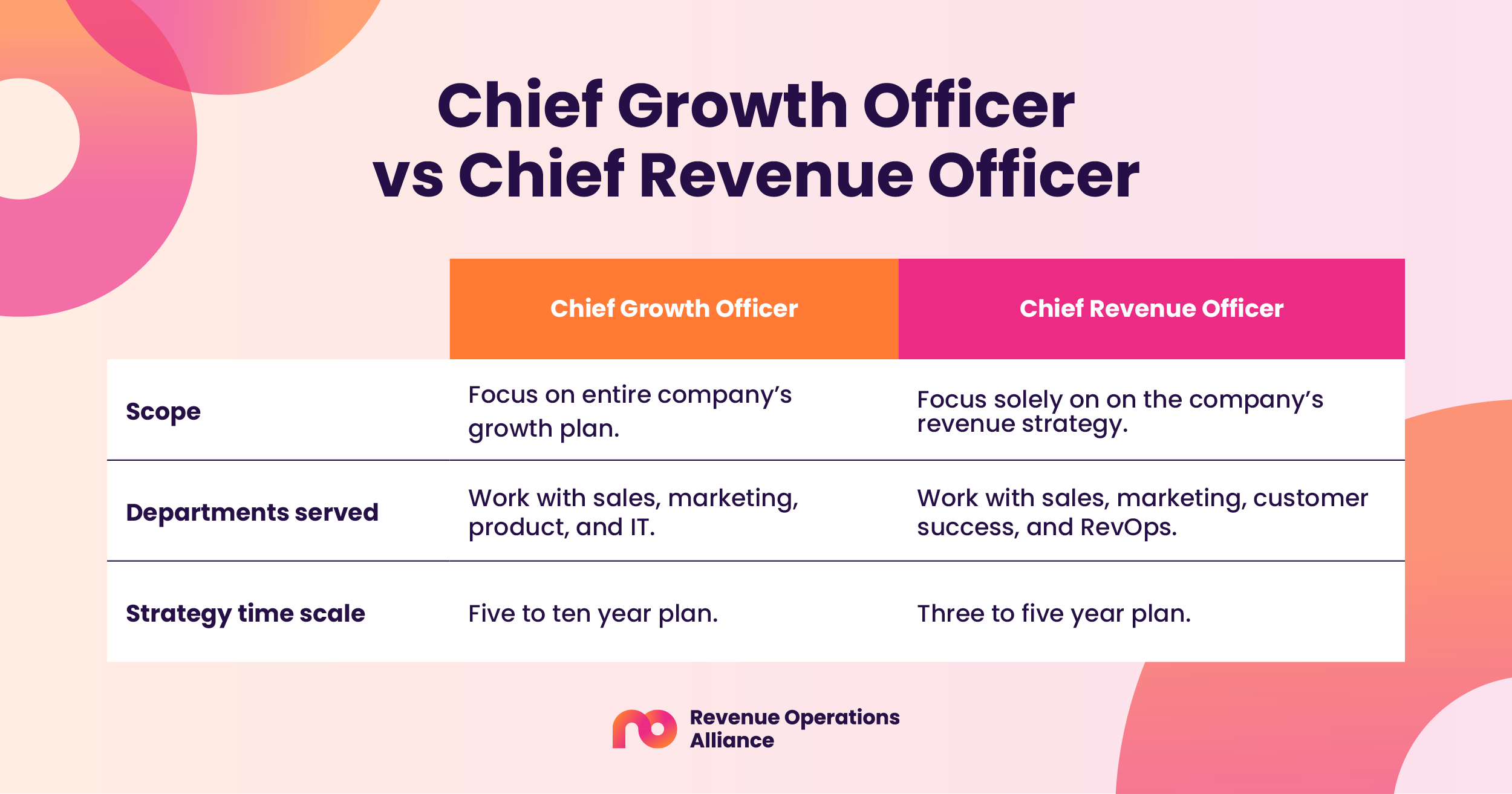In 2024, the Chief Growth Officer role is the number one fastest-growing job title in the U.S. according to LinkedIn’s latest report.
But what does a Chief Growth Officer or CGO do? And how does this C-suite role differ from a Chief Revenue Officer (CRO)? After all, both of these executives aim to drive growth to their organization.
The short answer is timeframe, but this article dives further into what a CGO does, why they’re needed, and how the role differs from a CRO.
Looking for something in particular? Skip ahead:
- What is a Chief Growth Officer (CGO)?
- What does a Chief Growth Officer do?
- Does your company need a Chief Growth Officer?
- What is a Chief Revenue Officer (CRO)?
- What’s the difference between a CGO and a CRO?
- Do you need a CRO and a CGO?
- Could a CRO transition to a CGO role? Or vice versa?
What is a Chief Growth Officer (CGO)?
As you might expect a Chief Growth Officer’s main goal is strategic growth.
But like most things, it’s not that simple. A CGO works cross-functionally between sales, marketing, product, and IT departments to promote long-term business development and growth. This requires building a forward-thinking vision company-wide.
CGOs also focus on identifying new opportunities for expansion and exploring new ways to reach your target audience. Chief Growth Officers often work closely with the CEO to determine the company’s vision for the next five to 10 years.

What does a Chief Growth Officer do?
A Chief Growth Officer oversees long-term growth strategy by removing silos, disrupting the status quo, and defining growth marketing strategies. CGOs also focus on the external factors that may impact your business such as market dynamics, customer feedback, and new opportunities for growth.
On a day-to-day level, the Chief Growth Officer’s role may look similar to a CEO’s as they work cross-functionally on high-level strategic planning to increase business goals and roll out these growth initiatives through the organization. The CGO’s biggest supporter is often their CEO.
Growth executives look beyond short-term sales and marketing strategies toward sustainable growth.
Responsibilities of a Chief Growth Officer
Here’s a quick breakdown of some of the day-to-day responsibilities of a Chief Growth Officer:
- Growth strategy. Creating a clear long-term plan for growth that aligns with the company’s goals.
- Alignment. Working with other departments to roll out strategy and ensure results.
- Market research. Understanding the market, customer trends, and spotting growth opportunities.

How to know if your company needs a Chief Growth Officer
Does your organization need a Chief Growth Officer? Here are a few things to consider before writing up a job description:
- What are your growth objectives and expectations?
- Do you have a growth marketing strategy?
- Does your current team have all the resources you need to achieve these goals?
- How would a CGO fit into these plans?
If your current growth strategy is defined and you already have the resources you need to achieve it, you likely don’t need a Chief Growth Officer right now. Instead, you might consider asking your current C-suite executives and senior leaders to take on some tasks related to ensuring organizational growth.
If your growth plan for the next five to 10 years is to move into a new vertical, region, or market, and your current executives are too busy to devote any more time to this plan, your organization might benefit from hiring a CGO.
Another reason you might want to consider hiring a Chief Growth Officer is if you’re losing market share or need to revitalize your brand. A CGO would be able to dive into understanding why you’re losing customers and build a strategy to reduce your losses (and start growing again).
When hiring a Chief Growth Officer, you must identify what projects and responsibilities you’d like them to tackle. And think ahead, after all, your new CGO will be planning toward your long-term goals.

What is a Chief Revenue Officer (CRO)?
A Chief Revenue Officer is another C-suite executive whose focus is on growth, but a CRO is more focused on revenue growth strategy than larger business initiatives. This isn’t to say being a CRO is a less intensive role though.
Chief Revenue Officers work to align sales, marketing, and customer success within their organization. This often comes with managing a revenue operations team, and may even mean the VP of Sales and VP of Marketing report to the CRO.
A CRO will focus on a one to three-year plan for increasing revenue through optimizing sales and marketing processes and streamlining the customer experience to promote sustainable growth.
Want to learn more about the ins and outs of the CRO role? Check out our full article on this. 👇

What’s the difference between a Chief Growth Officer and a Chief Revenue Officer?
So what’s the difference between these two emerging C-suite roles?
Here are the main three things separating the CGO and CRO roles:
- Scope
- Departments served
- Strategy time scale
Let’s take a deeper look at how to differentiate these roles.
Scope
The first difference between these roles is the scope of their responsibilities, while both executives will work on high-level business growth strategy, they have slightly different purposes.
Chief Growth Officers focus on the entire company’s growth plan including product development and moving into new markets.
Chief Revenue Officers, on the other hand, focus solely on the company’s revenue strategy including how to increase deals closed and customer retention rates.
Departments served
Since these roles have a different scope they also serve different functions within the business (with some overlap of course!).
CGOs work with sales, marketing, product, and IT departments to align these teams with organizational-wide growth.
CROs work with sales, marketing, customer success, and revenue operations departments to align these teams to increase revenue growth.

Strategy time scale
While both the CGO and CRO work on long-term growth plans, Chief Growth Officers tend to work in longer time scales than Chief Revenue Officers. The average CGO will work on five to 10 year plans, while the average CRO will work on three to five year plans.
The differences summarised
To summarise the differences between a CGO and a CRO we’ve created this graphic.

Do you need a CRO and a CGO?
At most organizations, there’s no real need to have both a Chief Growth Officer and a Chief Revenue Officer as they are remarkably similar positions. Most companies only require one of these roles to increase growth.
As for deciding which role to add to your ranks, that depends on your company’s priorities. If growing your revenue is the key goal of your org, a CRO is the way to go. But if you’re planning on expanding into a new market in the next few years, you may want to consider hiring a CGO instead.
That being said, large multi-national companies may have the space for both of these roles amongst their ranks, but the key is ensuring clear expectations are set to avoid too many overlapping duties.
Could a CRO transition to a CGO role? Or vice versa?
The simple answer is yes. Both roles require similar skills, so if you have experience in one you could easily switch to doing the other if you felt like a change of pace.
That’s not to say there isn’t some learning curve though as there may be some responsibilities you haven’t managed before. For example, if you’re a CRO with a sales leadership background, you might not have worked directly with a product team before.
Or if you’re a CGO with previous experience as a Chief Marketing Officer (CMO) you might not have worked directly on sales strategy in the past.
Overall, the strategic growth mindset, data-driven decision-making skills, and strong leadership required to do these roles successfully are transferable across these two roles.

TLDR;
- A Chief Growth Officer oversees long-term growth strategy by removing silos, disrupting the status quo, and defining growth marketing strategies.
- A Chief Revenue Officer is focused on revenue growth strategy and alignment within an organization.
- The main three things separating the CGO and CRO roles are scope, departments served, and strategy time scale.
- Most organizations don’t need both of these roles, one is usually enough.
- Both Chief Growth Officers and Chief Revenue Officers have similar skill sets so they would easily be able to transition between these roles.
Supercharge your path to the C-suite
Carve your path to the C-Suite with our expert-led masterclass. Over 6 weeks, learn from experts who've been there and done it and expedite your path to the top.
🚀 Develop exemplary soft skills required for C-suite execs, including resilience, prioritization, time-keeping, business strategies, and emotional intelligence.
💰 Recognize the typical structure of a corporate finance team and the key roles within that team.
🔍 Identify the success factors and key components of ‘disruptive leadership’ and a change management approach.
⚡ Quickly establish a company-wide vision and framework for developing and implementing a winning strategy.




